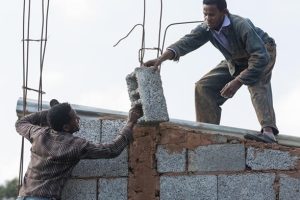There is wisdom in every culture. The ancestors of human being were handcrafters, innovators and hunters using stone cutting edge. Then it transforms into harvesting crop with traditional mechanisms. Agriculture was the first successful invention that initiates successive endeavors towards prosperity. Humans in the oldest ages carve caves to save their important documents and guiding principles.
That is why this time in different countries of the world archeologists and historians try to investigate ancient written and unwritten documents such as manuscripts, monument and ancient paintings on caves. And investigating this ancient heritages and documents is not only for the sake of discovering history but highly targets acquiring something special to learn from the past.
Thus, this age of industrialization and technology is said to be derived from the ancient cottage industry through time to time improvements. Addis Ababa City Administration Culture and Tourism Bureau Intangible Heritages Senior Expert Memhir Mekibib Gebremariam indicated that as Ethiopia is the land of origins, it is rich with diversified cultural assets.
This generation should be aware of his/her own cultural assets and value its significance. Culture lays the cornerstone in all aspects, he added. “Countries like Japan, China, South Korea, and India, among others are known for their inflexible socio-economic development. These countries have not duplicated or inculcate other country’s economic strategy. They grow with their own products, technological innovation and knowledge.
Their grand objective depends on exporting knowledge and products rather than importing. Thus, history shows that most country’s prosperity emanates from their priority to culture.” Culture could be reflected economically, socially, politically, psychologically and whatever in the day to day activities of humans.
As to him, Ethiopia once was among the world’s leading economy in history. The country is home to the mysterious and a single rock carved Rock Hewn Churches of Lalibela, Aksum Obelisks, Gonder Fasiledes Castle, among others. But, time has made the country to lose its former rank and struggle with drought and internal conflict.
The lack of leadership, prevalence of war and conflicts in the past have affected the country’s economy and lowered its international influence hugely. Currently, hopes of rays are beaming another golden time to the country in history. The leadership has now accredited for prioritizing citizens and strives for the benefit of its people. It is not odd to Ethiopians to live together despite some skirmishes here and there.
Now, tensions are easing and everyone’s eyes are shifting into how to transform the country towards its real renaissance. Keeping the prevailing peace the youths have to develop, appreciate and preserve their cultural assets.
There are untapped knowledge and preaching that the country has not utilized from Geez language, according to the same source. Higher education institutions ought to dig out what could be learnt from our culture and our ancestors and help the country to benefit from its own assets. It is now a common feature that other countries are investigating the mysterious Ethiopian Geez Language, for example, as many books are written in Geez language and documented in museums and Ethiopian Orthodox Tewahido Church. These books are very much informative. If the country undertakes deep investigation on the Language, it could be one of the competitive countries in terms of astronomy, medicine, architecture, industrialization, technology, among others.
According to Memehir Mekibib, leaders have a great responsibility in shaping and clarifying illusions of the youth towards own cultural assets. “Even if the country has approved a Cultural Policy, nothing has been implemented practically. We have our own hair dressing and cultural attire. Why do our ladies wear artificial hair [wig]? It is not totally acceptable to be adorning artificially. If we give due respect to our own cultural dressing, it will be a great potential to attract more tourists and promote the sector with our untouched culture. Ethiopians have their own cultural cosmetic.
There is no reason why we shouldn’t use and promote our owns.” Currently, Addis Ababa City Administration Culture and Tourism Bureau is working in coordination with pertinent stakeholders targeting promoting local cultural assets and utilizing it for socio-economic prosperity. “Doro Wot, Kitfo, Tej and Tela are the common cultural food and drinking in the Ethiopian culture. If we continue to be negligent to our cultural values, we might lose our delicious food and drinkings.”
Further than this, Ethiopians are known for having their own cultural instruments. “Sadly, our home, building, cities including office of the Ministry of Culture and Tourism do not represent Ethiopia’s culture. So, in the future we might face difficulties to find Ethiopia’s unique manifestations further to its ancient historical destinations. Thus, coordinated work is needed to keep our forefathers well inherited cultural assets.”
The active engagement of stakeholders like community leaders, representatives religious fathers, culture researchers and tourism experts as well as the youths are required to value own culture, he said. Ethiopia has diversified cultural assets. The Ministry of Culture has recognized only few of them. Cultural coffee ceremony, countless shared values and norms, lifestyle, the way elders treated are among the major cultural assets to be preserved well and inherited to the future generations.
To this effect, further detailed studies are required to discover and preserve all the 80 ethnicities’ cultural assets. Currently, the new generation seems forgetting own cultural assets and tilting towards other cultures. Though taking the useful one is commendable, the harm ones might affect the personality of individuals and leads to a crossroad while losing own cultural assets, the Expert indicated.
The practical implementation of Cultural Policy is also a solution to maintain the country’s glamorous cultural assets, he emphasized. Mahatama Ghandi of India has glorified the country after 200 years of occupation under Britain. Immediately with his appointment Ghandi has made a massive revolution on culture. He encouraged cultural assets to be developed, institutionalized and promoted so that widely be utilized across India.
Merkato, when first established in the 1950s, was intended to create opportunities for transaction of local cultural products. By the time two big halls were constructed to accommodate the trading. However, currently, the one hall is fully changed to goods imported from, he added. “We have to believe that culture is a means for development. And all of us have a responsibility of keeping and developing our best cultural assets.” As the Cultural Policy indicates, cultural industries have the potential to promote such values.
They also have significant contributions to empower the people, promote their history and be proud of their identity. However, the policy has not yet applied accordingly. The practical implementation of the policy, as aforementioned above, can be a solution to maintain the country’s glamorous cultural assets. To sum up, prioritizing and valuing own products would be more important than ever along with strengthening local industrialization and creating plentiful market opportunities to own products.
Herald January 23/2019
BY TEWODROS KASSA





